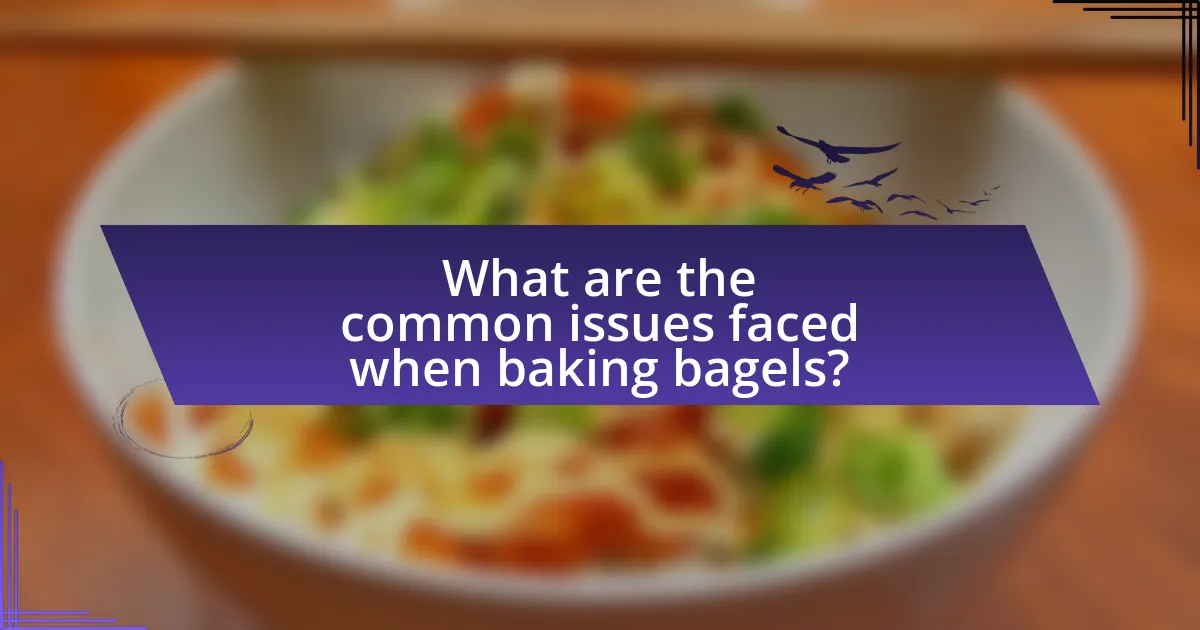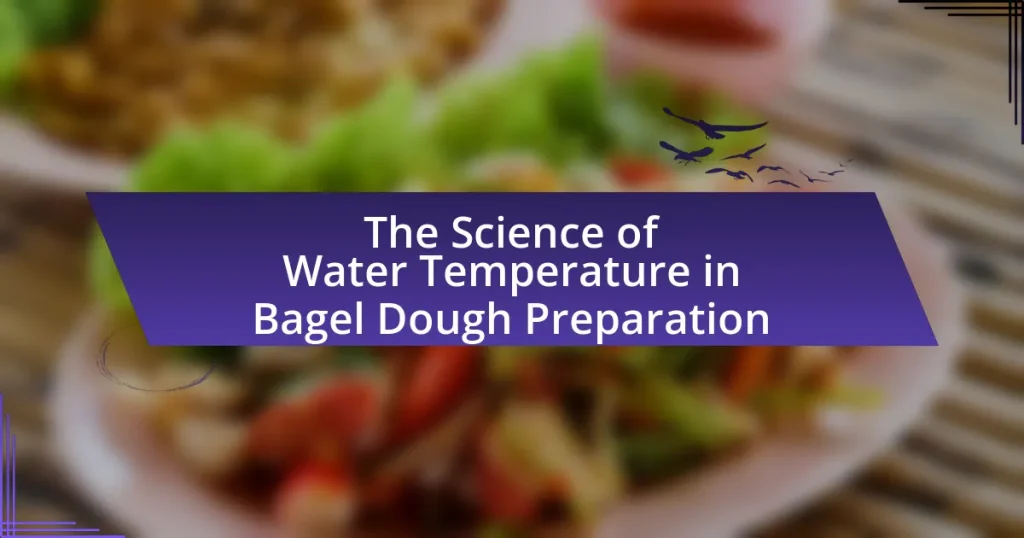The article focuses on troubleshooting common bagel baking issues, providing essential tips for achieving successful results. It addresses key factors such as boiling time, dough hydration, ingredient choices, and shaping techniques that significantly impact bagel texture and quality. The discussion includes the role of flour type and yeast quality in determining bagel rise, as well as best practices for consistent baking outcomes. Additionally, the article offers practical solutions for common problems like density, flavor, and crust quality, ensuring that bakers can refine their techniques for optimal bagel production.

What are the common issues faced when baking bagels?
Common issues faced when baking bagels include insufficient boiling time, incorrect dough hydration, and improper shaping techniques. Insufficient boiling time can lead to bagels that are dense and chewy rather than light and airy, as boiling helps to set the crust. Incorrect dough hydration affects the texture; too little water results in dry bagels, while too much can make the dough too sticky to handle. Improper shaping techniques can cause bagels to lose their shape during baking, leading to uneven cooking and undesirable appearance. These factors are critical for achieving the desired bagel quality.
How do ingredient choices affect bagel baking outcomes?
Ingredient choices significantly impact bagel baking outcomes by influencing texture, flavor, and overall quality. For instance, high-protein bread flour creates a chewier texture due to its gluten content, while all-purpose flour results in a softer bagel. Additionally, the type of yeast used affects fermentation speed and flavor development; active dry yeast provides a milder taste compared to instant yeast, which can enhance the bagel’s rise. The inclusion of malt syrup or sugar contributes to browning and flavor, as these ingredients caramelize during baking. Furthermore, the hydration level, determined by the amount of water relative to flour, affects dough elasticity and moisture retention, leading to variations in crust and crumb structure. These ingredient choices are critical for achieving the desired bagel characteristics, as evidenced by baking science principles that highlight the role of each component in the final product.
What role does flour type play in bagel texture?
Flour type significantly influences bagel texture by affecting gluten development and moisture absorption. High-protein flours, such as bread flour, create a stronger gluten network, resulting in a chewier and denser bagel, which is characteristic of traditional bagels. In contrast, lower-protein flours, like all-purpose flour, yield a softer and less chewy texture due to weaker gluten formation. Research indicates that the protein content in flour directly correlates with the final product’s structure and chewiness, with bread flour typically containing around 12-14% protein compared to all-purpose flour’s 10-12%. This difference in protein content is crucial for achieving the desired bagel texture.
How does yeast quality influence bagel rise?
Yeast quality significantly influences bagel rise by affecting fermentation efficiency and gas production. High-quality yeast, such as active dry or instant yeast, ensures a robust fermentation process, leading to optimal carbon dioxide production, which is essential for the dough to rise properly. In contrast, low-quality or expired yeast may result in insufficient gas production, leading to dense and flat bagels. Studies show that fresh yeast can double the dough volume within a specific timeframe, while poor-quality yeast may fail to achieve the same results, underscoring the importance of yeast quality in achieving the desired bagel texture and rise.
What baking techniques can lead to bagel problems?
Improper boiling techniques can lead to bagel problems, such as insufficient chewiness or a tough exterior. For instance, boiling bagels for too short a time results in a less developed crust, while boiling them for too long can create an overly dense texture. Additionally, using water that is not at the correct temperature can affect the bagel’s final texture; water that is too hot can cause the bagels to cook unevenly, while water that is too cool may not set the crust properly. These factors are critical because the boiling process is essential for achieving the characteristic bagel texture and flavor.
How does boiling time impact bagel density?
Boiling time significantly impacts bagel density; longer boiling times result in denser bagels. This occurs because extended boiling allows for more starch gelatinization and protein coagulation, which contribute to a firmer structure. Research indicates that boiling bagels for 30 seconds to 2 minutes enhances their density, as the outer layer forms a crust that retains moisture and creates a chewy texture. In contrast, shorter boiling times may lead to a lighter, airier bagel due to insufficient starch and protein development.
What is the effect of baking temperature on bagel crust?
Baking temperature significantly affects the crust of bagels, with higher temperatures leading to a thicker, crunchier crust. When bagels are baked at temperatures around 450°F to 500°F, the intense heat causes rapid moisture evaporation and promotes Maillard reaction, resulting in a desirable golden-brown color and a firm texture. Conversely, lower baking temperatures, such as 350°F to 400°F, may yield a softer, less defined crust due to slower moisture loss and insufficient caramelization. This relationship between temperature and crust quality is supported by baking science, which indicates that optimal crust formation occurs at higher temperatures, enhancing both flavor and texture.
Why is the shaping process critical in bagel baking?
The shaping process is critical in bagel baking because it determines the bagel’s final texture and structure. Proper shaping creates a uniform density and surface tension, which helps the bagel maintain its shape during boiling and baking. This is essential because bagels require a specific density to achieve their characteristic chewiness, which is a result of the gluten structure developed during shaping. Additionally, well-shaped bagels will have a consistent crust and crumb, enhancing the overall eating experience.
What common shaping mistakes lead to uneven bagels?
Common shaping mistakes that lead to uneven bagels include inconsistent dough tension and improper shaping techniques. Inconsistent dough tension occurs when the bagel is not rolled tightly enough or when the surface of the dough is not smoothed properly, resulting in a bagel that bakes unevenly. Improper shaping techniques, such as not forming a uniform hole in the center or failing to create a consistent thickness, can also contribute to uneven baking. These mistakes disrupt the bagel’s structure, leading to variations in size and texture after baking.
How can proper shaping techniques improve bagel quality?
Proper shaping techniques enhance bagel quality by ensuring uniformity in size and density, which leads to consistent baking results. When bagels are shaped correctly, they develop an even surface tension that allows for optimal expansion during boiling and baking. This results in a chewy texture and a well-formed crust. Research indicates that consistent shaping can reduce variations in moisture retention and heat distribution, ultimately improving the overall flavor and appearance of the bagel.

How can I identify specific bagel baking issues?
To identify specific bagel baking issues, observe the characteristics of the bagels after baking. Common issues include a tough crust, which may indicate over-kneading or insufficient boiling time; a dense interior, suggesting under-proofing or inadequate hydration; and a lack of shine, often due to insufficient boiling or using the wrong type of malt. Each of these indicators can help pinpoint the exact problem in the bagel-making process, allowing for targeted adjustments in technique or ingredients.
What signs indicate undercooked or overcooked bagels?
Undercooked bagels typically exhibit a pale color and a soft, doughy texture, while overcooked bagels are characterized by a dark, hard crust and a dry interior. The pale color of undercooked bagels indicates insufficient baking time, which prevents the Maillard reaction from developing the desired golden-brown crust. Conversely, the dark crust of overcooked bagels results from excessive baking, leading to moisture loss and a tough texture. These visual and textural cues are essential for determining the doneness of bagels during the baking process.
How can I tell if my bagels are too dense?
Bagels are too dense if they feel heavy and lack a light, airy texture when you bite into them. A dense bagel often results from insufficient kneading, inadequate fermentation, or using too much flour in the dough. The ideal bagel should have a chewy crust and a soft, airy interior, which can be tested by gently squeezing the bagel; if it feels overly firm and does not spring back, it is likely too dense. Additionally, if the bagels do not have a noticeable rise during boiling or baking, this indicates density issues.
What visual cues suggest bagels are overbaked?
Overbaked bagels typically exhibit a dark brown or burnt exterior, indicating excessive baking time or temperature. Additionally, they may have a dry, hard texture rather than a chewy consistency, which is characteristic of properly baked bagels. The presence of cracks or an overly crisp crust can also suggest that the bagels have been overbaked, as ideal bagels should have a slight sheen and a soft, pliable surface.
How do I troubleshoot common bagel baking problems?
To troubleshoot common bagel baking problems, first identify the specific issue, such as dense texture, lack of shine, or improper shape. For dense bagels, ensure you are using high-gluten flour and that the dough is adequately kneaded to develop gluten. If bagels lack shine, consider increasing the boiling time or adding malt syrup to the boiling water, as this enhances the crust. For improper shape, ensure the dough is rolled tightly and shaped correctly before boiling. These methods are supported by baking science, which emphasizes the importance of gluten development, boiling techniques, and proper shaping in achieving the desired bagel characteristics.
What steps can I take if my bagels are too chewy?
To reduce chewiness in bagels, consider adjusting the boiling time and the flour type used. Over-boiling bagels can lead to a tough texture; aim for a boiling time of 30 to 60 seconds per side. Additionally, using high-gluten flour can contribute to chewiness; switching to all-purpose flour may yield a softer bagel. These adjustments are supported by baking science, which indicates that the protein content in flour and the cooking method significantly affect texture.
How can I fix bagels that lack flavor?
To fix bagels that lack flavor, incorporate additional ingredients such as salt, malt syrup, or honey into the dough. Salt enhances the overall taste, while malt syrup or honey adds sweetness and depth. According to baking experts, the ideal salt content in bagel dough is around 1.5-2% of the flour weight, which significantly improves flavor. Additionally, boiling bagels in water mixed with malt syrup before baking can also enhance their taste and texture.

What are the best practices for successful bagel baking?
The best practices for successful bagel baking include using high-gluten flour, properly boiling the bagels, and baking at the right temperature. High-gluten flour, which contains more protein than all-purpose flour, contributes to the chewy texture characteristic of bagels. Boiling the bagels for 30 seconds to 1 minute before baking creates a shiny crust and helps set the shape. Baking at a temperature of 425°F to 475°F ensures a well-cooked interior while achieving a golden-brown exterior. These practices are supported by culinary experts who emphasize the importance of these steps in achieving authentic bagel quality.
How can I ensure consistent results when baking bagels?
To ensure consistent results when baking bagels, maintain precise measurements and follow a standardized recipe. Accurate ingredient ratios, such as using 1 part yeast to 4 parts flour, contribute to uniform dough consistency and fermentation. Additionally, controlling water temperature to around 110°F promotes optimal yeast activity, while boiling bagels for 30 seconds on each side ensures a chewy texture. Consistency in baking time, typically 20 minutes at 425°F, further solidifies the final product’s quality. These practices are supported by baking science, which emphasizes the importance of ingredient ratios and temperature control in achieving reliable outcomes.
What measurements are crucial for perfect bagels?
The crucial measurements for perfect bagels include a flour-to-water ratio of approximately 5:3, using about 4 cups of bread flour to 1.5 cups of water. Additionally, the ideal salt measurement is around 1 tablespoon per batch, and the yeast should be approximately 2 teaspoons. These specific ratios ensure the right dough consistency and flavor. The bread flour’s protein content, typically around 12-14%, contributes to the bagel’s chewy texture, while the salt enhances flavor and controls fermentation.
How does resting dough improve bagel texture?
Resting dough improves bagel texture by allowing gluten to relax, which results in a chewier and more uniform structure. When dough rests, the proteins in the flour hydrate and align, leading to better elasticity and extensibility. This process also helps to reduce surface tension, making it easier to shape the bagels and ensuring they maintain their form during boiling and baking. Scientific studies indicate that resting periods can enhance the overall quality of baked goods by promoting optimal fermentation and gas retention, which are crucial for achieving the desired texture in bagels.
What tips can enhance the flavor of my bagels?
To enhance the flavor of bagels, incorporate ingredients such as malt syrup or honey into the dough, as these sweeteners contribute to a richer taste and improved browning during baking. Additionally, boiling bagels in water mixed with baking soda can create a slightly alkaline environment, which enhances the crust’s flavor and texture. Using high-quality flour, such as bread flour, increases the protein content, resulting in a chewier bagel that holds flavor better. Finally, adding toppings like sesame seeds, poppy seeds, or everything bagel seasoning before baking can provide an extra layer of flavor.
How can I incorporate toppings effectively on bagels?
To incorporate toppings effectively on bagels, apply them before baking to ensure they adhere properly. This method allows toppings like sesame seeds, poppy seeds, or everything seasoning to bond with the bagel’s surface during the baking process, enhancing flavor and texture. Research indicates that toppings applied before baking can create a more cohesive and flavorful experience, as the heat helps to toast and intensify their flavors.
What are some flavor variations to try for bagels?
Some flavor variations to try for bagels include everything bagel seasoning, garlic, onion, sesame, poppy seed, cinnamon raisin, and jalapeño cheddar. These flavors enhance the traditional bagel experience by adding distinct tastes and aromas. For instance, everything bagel seasoning combines sesame seeds, poppy seeds, garlic, onion, and salt, creating a savory profile that is popular among bagel enthusiasts. Cinnamon raisin bagels offer a sweet alternative, appealing to those who enjoy a hint of sweetness in their breakfast. Each variation caters to different palates, making bagels versatile for various meal occasions.
What are the key takeaways for troubleshooting bagel baking issues?
Key takeaways for troubleshooting bagel baking issues include ensuring proper dough hydration, maintaining accurate fermentation times, and monitoring water temperature during boiling. Proper hydration, typically around 60-65%, affects the bagel’s texture; too little water results in a dry bagel, while too much can lead to a gummy texture. Fermentation times should be closely followed, as under-fermented dough can lead to dense bagels, while over-fermentation can cause them to collapse. Lastly, boiling water should be at a rolling boil, ideally around 212°F, to achieve the desired crust; insufficient boiling can result in a pale, soft exterior. These factors are critical for achieving the ideal bagel consistency and flavor.



